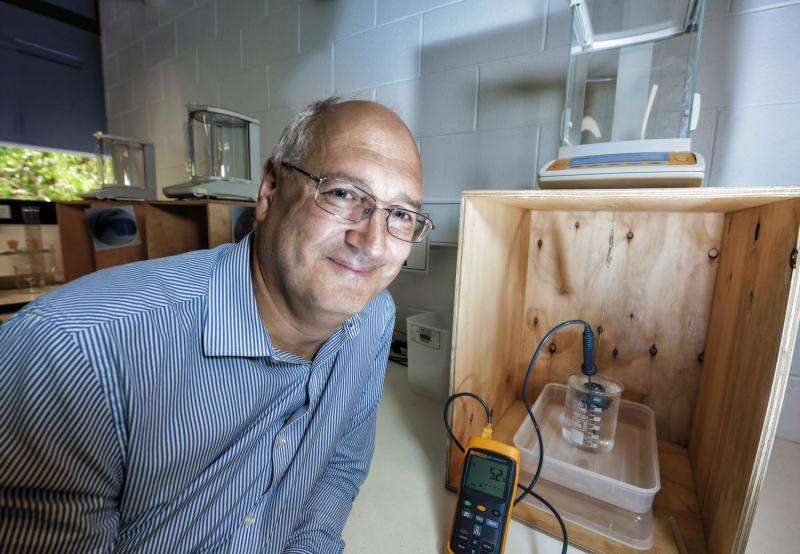MacGyver this! New DIY experiment shows students the physics of climate change

Fishing line, paper clips, glass marble, glue - no, not the makings of a MacGyver episode but a new experiment that lets students precisely measure the effects of global warming on oceans.
Developed by QUT physicists Dr Stephen Hughes and Darren Pearce and published recently in the European Journal of Physics, the experiment uses Archimedes' principle to demonstrate that oceans expand as they heat up, causing sea levels to rise, even without factoring in melting ice sheets.
"This process is called thermal expansion - a concept that's traditionally been very difficult to demonstrate in a teaching lab because one litre of water will expand by only 0.2ml per degree Celsius," said Dr Hughes from the QUT Science and Engineering Faculty's School of Chemistry, Physics and Mechanical Engineering.
"This new experiment uses a glass marble immersed in a beaker of water, with the marble suspended by fishing line and paper clips from an overhead electronic balance.
"The weight of the marble increases as the water is warmed because water loses buoyancy as it expands and its density decreases."
Archimedes' principle describes how the weight of an object immersed in water is reduced by an amount equal to the weight of the water displaced.
Dr Hughes said this law of buoyancy means the buoyancy of an object changes if the water density changes.
"For example, if a ship were to travel from the Arctic to the tropics it would float lower because warm water is less dense than cold water," he said.
"We're using the same effect - except with glass marbles on a much smaller scale.
"My first-year physics students find the experiment quite easy because the volume of the marble can be measured precisely by the instructor before the experiment and the students can read all the other measurements they need directly from digital instruments and without needing to take great care to measure the volume.
"Of course, the experiment isn't foolproof - there are a couple of potential sources of error, and students need to conduct the experiment carefully to get good results. But the fact that there are sources of error provides a golden opportunity for discussion with the students.
"What I really like about this experiment is that it gets students to engage with physics of climate change because they can use key equations in the experiment to estimate the increase in sea level for a 2 per cent rise in global average temperature - 0.37mm for each metre depth of sea water."
Dr Hughes said there were two main causes of rising sea levels - thermal expansion and melting land-based ice.
"Thermal expansion is responsible for most of the rising sea levels during the past century but an increasing amount of rising levels into the future will be due to the melting Greenland and Antarctic ice sheets, as well as melting glaciers across the globe, especially the Himalayas," he said.
Scientists have previously confirmed the average sea level rose 200mm and the average ocean temperature increased by 0.85 oC between 1880 and 2010.
"It's interesting to apply this experiment to the established 1880-2010 increase," he said.
"One of the key equations used in this experiment implies that most of the thermal expansion has occurred in the top 25 per cent of the oceans.
"Although the rising sea level is a global phenomenon and will affect all coastal cities, some places are more vulnerable than others.
"For example, the sea level on the North American Atlantic coast north of Cape Hatteras is rising three to four times faster than the global average, which has been attributed to a reduction in the strength of the Atlantic Meridional Overturning Current."
More information: European Journal of Physics, iopscience.iop.org/article/10. … 143-0807/36/6/065033
Provided by Queensland University of Technology





















